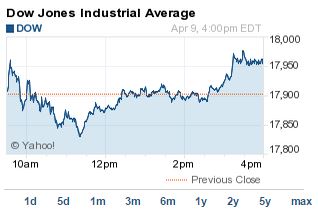For April 8, 2015, here's how the stock market did today, the top stock market news, and stocks to watch based on today's market moves...
How Did the Stock Market Do Today?
 Dow: 17,958.73, +56.22, +0.31%
Dow: 17,958.73, +56.22, +0.31%
S&P 500: 2,091.18, +9.28, +0.45%
Nasdaq: 4,974.56, +23.74, +0.48%
The DJIA today gained 56 points as oil prices rebounded and lifted energy stocks. But the dollar's strength limited today's upside and fueled uncertainty over corporate profits as earnings season gets underway.
The S&P 500 Volatility Index (VIX), the market's fear gauge, dipped 5.79% on the day.
Top Stock Market News Today
- Rate chatter continued as investors try to pinpoint when the Federal Reserve will tighten monetary policy. Yesterday's release of minutes from the March FOMC meeting indicated a growing divergence of opinion between members of the central bank. With employment in focus, the total number of Americans who filed for unemployment benefits increased by 14,000 to 281,000 for the week ending April 4. The four-week moving average for unemployment benefits is now at its lowest level since 2000, indicating structural improvements in the jobs market and hinting that March's poor jobs report was a one-time fluke.
- Oil prices were up on the day after positive economic reports in Germany signaled improved health for the Eurozone's largest economy. In addition, growing uncertainty continues to spread across the markets over a possible deal between the United States and Iran over the latter's nuclear program. Brent oil, priced in London, gained 1.8% to $56.57 per barrel. WTI crude, priced in New York City, added 0.7% to hit $50.79 per barrel.
- Shares of Exxon Mobil Corp. (NYSE: XOM) were up 0.7%; Chevron Corp. (NYSE: CVX) gained 0.27%, and Royal Dutch Shell (NYSE: RDS.A) slipped 0.67% as investors continue to raise new concerns over its massive purchase of BG Group Plc. (OTCMKTS ADR: BRGYY) for 47 billion pounds ($70.2 billion).
Stocks to Watch: AA, BBBY, WBA, ZNGA, AAPL
[epom key="ddec3ef33420ef7c9964a4695c349764" redirect="" sourceid="" imported="false"]
- Stocks to Watch No. 1 and 2, AA, BBBY: It was a tough day for the first companies to report second-quarter earnings. Shares of Alcoa Inc. (NYSE: AA), whose report kicks off earning season, slipped 4% this morning after the company reported weaker than expected revenue Wednesday, despite beating estimates for earnings per share. Meanwhile, retailer Bed Bath & Beyond Inc. (Nasdaq: BBBY) saw shares plummet 5.43% Thursday after the company missed analyst expectations.
- Stocks to Watch No. 3, WBA: Shares of Walgreens Boots Alliance Inc. (Nasdaq: WBA) surged 5.6% on positive second-quarter earnings and news that the company is planning a massive restructuring program. Walgreens said it plans to close roughly 200 stores. The firm reported earnings of $2.06 billion, or $1.93 per share. Excluding special items, per-share earnings were $1.18, beating analyst expectations of $0.95 per share.
- Stocks to Watch No. 4, ZNGA: Shares of mobile game developer Zynga Inc. (Nasdaq: ZNGA) slipped nearly 18% today on news that CEO Don Mattrick is stepping down. The decision will put founder Mark Pincus back in charge. The developer of popular games like "Farmville" and "Words with Friends" has struggled this year, with its share price down more than 41%. Pincus will attempt to turn around the tech company by focusing its future on mobile data and customer analytics.
- Stocks to Watch No. 5, AAPL: Shares of Apple stock were up 0.76% this afternoon ahead of an important day for the company. Tomorrow, Apple Inc. (Nasdaq: AAPL) will allow its new Apple Watch to be accessible for preview and pre-orders. The preview comes as increasing chatter indicates that investors are concerned about the impact of a stronger dollar on the company's foreign profits. Yesterday, the tech giant received a rare stock downgrade from Societe Generale SA (OTCMKTS ADR: SCGLY). The bank raised concerns about the dollar's impact on earnings and the high sales price of the iPhone.
- Stocks to Watch 6, STZ: Shares of Constellation Brands Inc. (NYSE: STZ) were up nearly 1% this afternoon after the company beat earnings expectations and announced plans for its first dividend in company history. The maker of beer and alcohol will provide its first cash dividend since going public in 1973. Strong growth in its Mexican beer segment continues to propel the stock higher. Constellation announced fourth-quarter earnings of $215 million, or $1.06 a share. Excluding certain items, per-share earnings were $1.03, beating expectations of $0.94.
How to Make Money in the Stock Market Today
Every day we give investors a "tip of the day" to find their best profits. Today's tip comes from Money Morning Chief Investment Strategist Keith Fitz-Gerald:
The only thing standing between your portfolio and catastrophic loss is your own caution and proper risk management.
Risk management may not be the most exciting part of investing. But it is the most important.
And a tool called "position sizing" stands out above all others as the most powerful, and not just for cutting risk either, but for boosting your profits, too.
The concept is simple. Controlling the amount of money you place in each trade can lead to bigger profits and mitigate the risk of a catastrophic loss.
Position sizing is the science of cutting risk in your portfolio down to the bone. It answers the question "How big should I make my position for any one trade?"
Many investors think they have this covered with trailing stops that take them out of an investment when some predetermined limit is hit.
Position sizing is different. It's about determining how much of something you can buy for maximum profits, or even if you can afford to buy in the first place.
Understanding position sizing will put you miles ahead of other investors who spend all their time wondering what to buy while ignoring the critical question of how much to buy.
To learn three different methods for sizing your positions, with step-by-step instructions for each, go here: This One Risk Management Tool Made the Difference Between Bankruptcy and $13 Million
About the Author
Garrett Baldwin is a globally recognized research economist, financial writer, consultant, and political risk analyst with decades of trading experience and degrees in economics, cybersecurity, and business from Johns Hopkins, Purdue, Indiana University, and Northwestern.



